5 Out Basketball Offense - The Comprehensive Guide!
5 Out offense is all the rage! And for good reason. It works.
It’s great for all age levels… from high-level concepts at the NBA or professional levels… to foundational concepts for youth players!
Before we dig into the good and the bad of 5 Out offense, there’s a couple things to keep in mind.
5 Out is a formation more than an offense. You can run a number of offenses from a 5 Out formation.
Some would fit the description of 5 out motion offense. Others would be 5 out continuity offenses. You could even run a 5 out dribble drive offense.
This guide will take you through everything you want to know to implement 5 Out basketball offense. Pick and choose what works for your team.
Contents
Benefits & Drawbacks
The strengths and weaknesses might vary somewhat depending on what type of 5 Out offense you run.
That said, there are some common strengths and weaknesses that most 5 Out offenses have.
To get a FREE PDF of 72 Drills & 33 Plays, click the banner below!
6 Benefits of 5 Out Basketball Offense
-
Space at the rim - playing 5 out opens up the paint. When you play with a post player, that plants a defender close to the basket.
Aligning in a 5 Out formation opens up the paint by removing defenders. This should create easier finishing opportunities at the rim. It should also open up opportunities for cutting.
-
Positionless basketball - this is crucial at all levels. We no longer see the tallest players anchored to the block. Some of the most skilled players in the NBA and WNBA are taller players.
This is even more important at the youth level. It’s nearly impossible to predict how players will physically develop. Playing 5 Out develops everyone as an all around player.
-
Good transition defense positioning - in 5 Out, you’ll have players located above the free throw line. This puts them in an ideal position to get back.
When your spacing gets out of whack, it can open up transition opportunities for your opponent. 5 Out spacing should prevent that from occurring.
-
Options - from the 5 Out alignment, you can quickly and seamlessly get into almost any action. If you want to focus on cutting, the rim is open.
If you want to focus on screening, players can pass and pick away (or pass and follow into a ball screen).
If you want to post, you can post a cutter. This can be harder to guard than a permanent post because of the element of surprise.
-
Hard to scout - because of the variety of options, 5 Out is hard to scout. This prevents your opponents from being able to lock in on 1-2 go to actions.
If you look at the Flow Motion Offense, it’s impossible to scout. Every possession is different and there are no patterns.
-
Easy to progress - even though there are a lot of options in 5 Out, you can start small. You could be a really tough team if you just got excellent at a simple pass and cut offense.
Then, over time, you can add more. You don’t have to put in 5 things at once. In 5 Out, you can scale your offense up over the course of the season.
The Zoom Offense is a great example of this. You can start with the simplified version in the video and then progress as players get more comfortable and confident.
4 Weaknesses of 5 Out Basketball Offense
-
Single driving gaps - this could be the singlest biggest drawback to 5 Out. The driving lanes are smaller. This makes it harder to penetrate.
Defenders who are one pass away have the ability to stunt at drives and still get back to their player.
To solve that, teams should have a penetration reaction system in place that opens driving lanes.
Also, keep in mind that 5 out is just a starting position. Most 5 out motion offenses don’t remain 5 out for very long. When players get into cutting or screening actions, the gaps grow and allow for drives.
-
Limited skill sets - some players are unskilled. As coaches, we must develop them. However, it’s not always possible for players to make a huge leap.
This can put players in a tough position. Some players don’t (yet) have the skill to handle the ball on the perimeter. They might not be good decision makers.
While you can help them develop their skill over the long run, there might be growing pains in the short term.
In the Flow Motion Offense, Coach Matt Lewis solves this problem by giving each player certain options to choose from. The more skilled you are, the more options you have.
Not only does that help account for players with less skill, it also gives them an incentive to improve!
-
Player IQ - playing 5 Out requires a solid level of basketball IQ. Players must be able to read and react to their teammates.
5 Out is generally not a pattern offense. Even if you just pass and cut, players must be able to recognize how they are being played and what type of cut to make.
If they are being denied, they must immediately cut backdoor. If their teammate drives, they must react appropriately.
This takes time and patience!
-
Takes more effort to combat switches - if your opponent thinks you’ll be keeping all your players around the perimeter, they might be more likely to switch. They might do this because they won’t be as worried about mismatches if all players are on the perimeter.
As with any offense, you want to be able to take advantage of mismatches. When you get a favorable mismatch, you need to create space (if a slower player is now guarding one of your quicker players) or a rim threat (if a smaller player is now guarding one of your taller players).
All In On 5 Out?
5 out is a great alignment for running your offense. Even the weaknesses noted above can be accounted for and minimized.
No matter your level, 5 Out is a great way to improve players. It allows every player to develop all parts of their game. It also gives coaches a lot of flexibility. Let’s explore that next.
If you’re looking for a 5 out offense that incorporates and teaches these advantages and concepts, click the box below.
Rules & Alignments Of 5 Out Basketball Offense
As a reminder, 5 Out is not an offense. It’s an alignment (more on that below).
So the rules of your offense will depend on what type of 5 Out offense you run.
That said, there are some general principles that apply to almost all 5 Out offenses. Here are 5!
5 Principles of 5 Out Basketball Offense
-
Pass and create or keep space - when you pass from a perimeter spot, you have options.
Some offenses have players cut to the rim (see below). Tim Schuring’s motion offense uses this as a core action. If so, make sure players put their head under the rim. Too many players don’t cut to score.
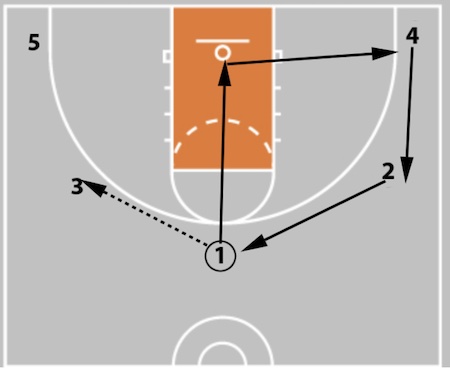
Some offenses have players cut to space. They might cut through to the opposite corner. This is an unselfish cut that must be done with pace to make the defense move.
Other offenses have players hold space. One example of this would be a player passing up out of the corner. That’s not a great cutting situation.
Holding the corner might be more valuable in that situation. Coach Lewis teaches this as a primary option for players not involved in a ball screen within the Flow Motion.
-
Maintain 4 point line spacing - offense is spacing. Most players use the 3 point line as their landmark. That’s okay but not ideal.
By backing out to the 4 point line (imagine the NBA 3 point line), players give themselves an additional 3-4 feet to work with.
This expands the defense. It leads to more space for cuts and drives.
-
When overplayed, go backdoor - this must become automatic. Anytime someone is denied on the perimeter, they must immediately plant a foot and sprint to the rim.
Coach Steege discusses this within the Zoom Offense:
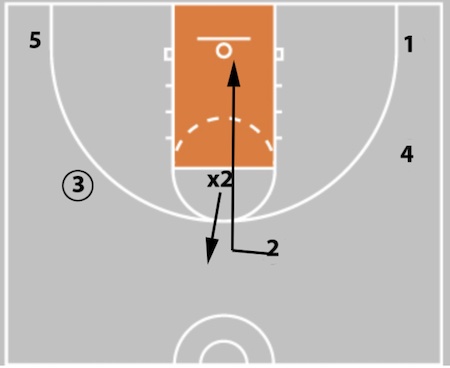
Because the basket area is open, this should create scoring opportunities.
-
Fill in & fill out with pace - when filling a spot, fill with pace! This makes your players much harder to guard. Sprint to the next spot. On the catch, they might be able to immediately drive or shoot.
Likewise, after a cut, sprint back out to the perimeter. The longer players take to fill out, the more time a defender is close to the rim. Into space, out of space!
-
Get out of the lava - think of the area between the 3 point line and key as lava. You don’t want your players catching in the lava. They should be catching the ball above the 3 point line or at the rim.
If they are catching in the lava, you have lost your 5 Out formation. See where you’re breaking down and reverse engineer to your desired 5 Out spots.
2 Common 5 Out Alignments
-
Point - wings - corners:

This is the most common 5 Out alignment. You have a player positioned up top. Two players fill the wings. Two players fill the corners.
It generally does not matter who is in what spot. Many teams end up with their 5 man at the top after inbounding and trailing.
From this formation, the floor is balanced. The ball can naturally be reversed through the top spot.
-
Slots - wing - corners:

This is a non-traditional spacing alignment that has become more popular.
Coach Rob Brost uses this formation when teaching his transition offense.
The advantage is that it gives a couple players bigger gaps to attack. In the diagram above, 2 & 4 have bigger driving lanes on the left side of the floor.
The single gap spacing is a drawback of 5 Out. This alignment fixes that for a couple players.
Conversely, the gaps on the right side of the floor are even smaller. It also might be harder to reverse the ball from this formation.
Written In Pencil
The rules of 5 Out can be tweaked to the strengths of your players. That’s one of the advantages.
For example, Coach Matt Lewis uses what he calls “motion menus” for his players within his 5 out motion offense. It gives each player certain actions that they can perform.
This is a great way to balance freedom with structure… and making sure your players are playing to their strengths!
As you plan your 5 Out, make sure the rules and alignment fit your personnel. If so, you’re well on your way to a dynamic offense!
Learn more about Flow Motion by clicking below.
5 Key Teaching Points For 5 Out Youth Basketball Offense
5 out offenses are great for youth teams. They give all players the chance to possess the ball and make decisions.
It’s impossible to predict how players will develop physically as they age. Teaching all your players how to play on the perimeter prepares them for that eventuality in the future.
5 out offense teaches players the importance of spacing. It teaches them how to react to penetration. It teaches the value of reversing the ball.
All of those are important concepts to learn. Yes, your 5 out offense at the youth level might have rules. But it will also teach basic principles. These will increase your players’ IQ and give them a leg up on their competitors.
As you teach 5 out, here are 5 key teaching points for your players:
1 The importance of cutting
Players must cut hard! Too many players jog their cuts.
It doesn’t matter whether you have players basket cut, brush cut, or cut away to the opposite corner for space.
Players must believe their cuts are important.
To convince them of this, you might start with basket cuts. At the youth level, hard basket cuts will produce a good number of scoring opportunities. . . if players cut hard.
Starting with this action incentivizes hard cuts because all players like to score!
To make this work, other players must be drilled to look for cutters. In many youth games, cutters are open but the player with the ball isn’t looking for or anticipating the pass.
One way to reinforce this habit is to make it a turnover when players don’t square up on the catch.
If you later add other types of cuts, stress the unselfish benefits of hard cutting. When a player cuts hard, that occupies their defender. This opens up opportunities for their teammates.
Good teammates cut hard all the time!
2 Creating & recognizing gaps
One of the challenges of 5 out spacing are the single gaps it creates. There are a couple key points to teach players with regards to this.
First, players should not drive single gaps! Bad things generally happen when they do. Defenders are able to swipe at the ball and cause turnovers.
(This can largely be rectified if players learn push/pull penetration principles - covered later in this guide).
Second, to go back to cutting, cuts create bigger gaps. When a player cuts hard, that opens space for a drive.
Players should look to drive into areas where a teammate just cut. They will have more space to drive, increasing the odds of success.
3 Play on both sides of the floor
Most youth offenses play on the right side of the floor about 85% of the time. That’s because about 85% of the players are right handed.
Very few youth players can attack or pass with their weak hand.
However, if you let this happen, your team is much easier to guard (and your players’ development is stunted).
Make your players play on both sides of the floor. You can do this in multiple ways. Work on weak hand development in practice. Make baskets scored on the left side of the floor worth double points. Put in a constraint that the top spot is a swing spot. When a player receives a pass at the top, they must immediately pass it opposite of where they got it from.
With repeated emphasis, players will begin to utilize the whole court. Once they do, your offense will blossom!
To get a FREE PDF with 20 Youth Drills & 3 Practice Plans, click the banner below!
4 Stay out of the ‘lava’
Almost every child is familiar with the game ‘floor is lava’. In the game, they must not let their feet touch the floor.
In 5 out offense, you want your players to think of the area between the 3 point line and the paint as lava.
Many youth players cannot capably shoot 3’s. One consequence of this is that players continually creep in towards the basket. Before long, your 4 point line spacing is now 15 foot spacing.
That shrinks the space the offense has to operate. It also shrinks the space the defense has to defend.
Consider making catching the ball in the ‘lava’ a turnover.
Keep your spacing! Even if players aren’t yet able to shoot 3’s, there is value to that spacing. It spreads out the defense, giving the offense more space to work with.
5 Advantage>Offense
This is a problem of all youth offenses, not just 5 out. Players need to remember that the goal of offense is to score, not to run offense.
Thus, you need to teach players what types of advantages they should be looking for.
Some of the advantages they need to be able to identify and exploit are:
Defender denying a filling player
Defender overplaying a filling player
Defender sagging way off
Defender trailing a filling player
Player cutting across the face of their defender
Defender turning their head to their player and losing sight
Defender making a long closeout
Defense in rotation
When you create one of those advantages, your goal is to attack and create a good shot. Too many players continue to ‘run the offense’ even after an advantage has been created.
Remind your players to have an attacking mindset once they have the advantage.
More Than Pass & Cut
5 out youth offenses are sometimes derided as simply being pass and cut.
While pass and cut should be part of a 5 out youth offense, it shouldn’t be all of it.
5 out has so much more to offer teams at every level, youth included.
But to utilize its strengths, players must be taught principles of good offense.
If they learn these 5, they (and your team) will be well on their way!
To learn more about 5 out youth basketball offense, click the box below!
5 Out Basketball Zone Offense
When people talk about 5 Out offense, they generally think of using it against man to man defenses.
That’s where it’s most used. Even if you run 5 Out offense against man defenses, you don’t have to use it against zone. Your team might benefit from a different zone offense. If so, that’s fine.
However, a 5 Out alignment can also be effective against a 2-3 zone defense.
The beauty of that is that you can teach 1 offense with different modifications depending on what your opponent is playing.
Let’s take a look!
5 Out Zone Offense
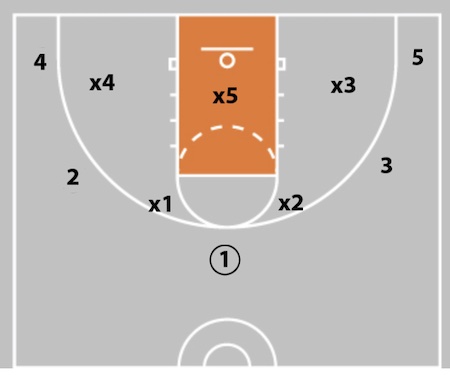
Start in a traditional 5 Out alignment.
This puts players 1, 2 & 3 in gaps between the zone defenders.
It’s critical they stay in those gaps. That creates confusion among zone defenders. It also opens up driving gaps.
Point to wing pass:
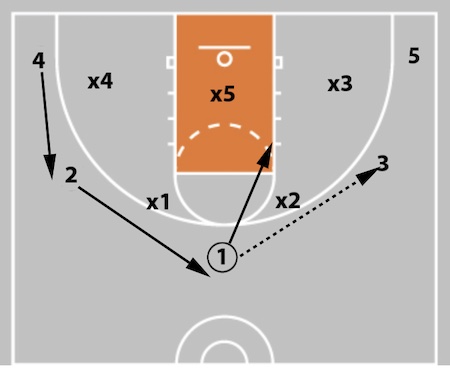
As with most zone offenses, you want to attack the high post. You are not starting a player there, so you need to cut someone to that area.
There are two options.
You could have the passer immediately cut to the high post.
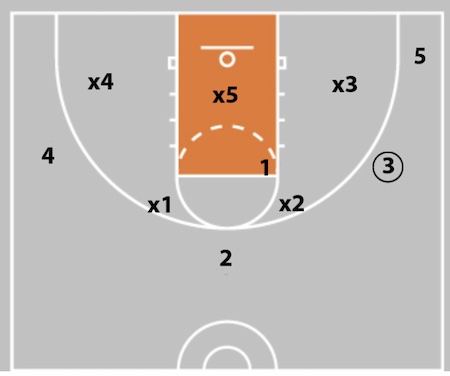
2 and 4 would fill up, leaving you in this formation
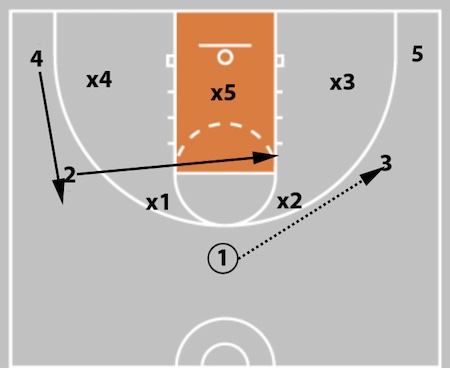
The other option is to cut the opposite wing. The advantage of this cut is that it’s harder for the defense to see.
When the ball is passed from 1 to 3, X1 and X2 will turn their bodies towards 3.
This leaves them blind to 2’s cut, making it harder to defend.

If you choose this option, 1 will hold the top and 4 will fill up to the wing.
Pass to the corner:
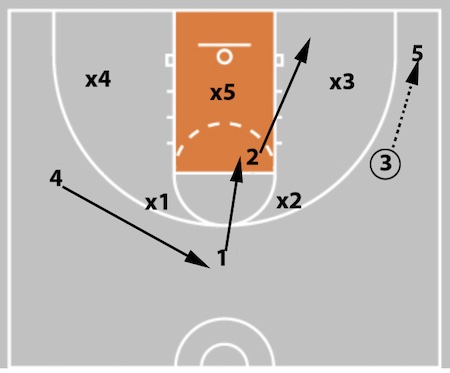
Another area where zones are vulnerable is the short corner.
On a pass to the corner, the player in the high post should cut to the ball side high post (see 2 above).
The player at the point should cut to the high post. As with the cut from the opposite wing described above, this is a hard cut for the defense to see coming.
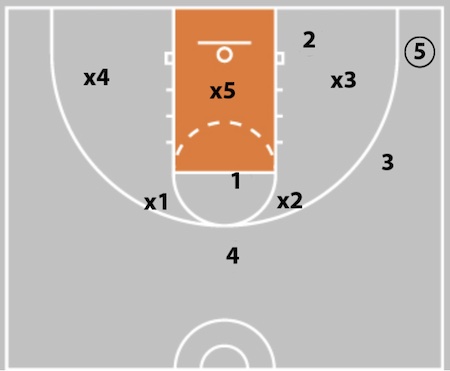
4 fills the top, leaving you in this alignment. This overloads the zone, making 4 defenders guard 5 offensive players.
Pass to the high post:

If you can get the ball to the high post, you are on your way to a great shot.
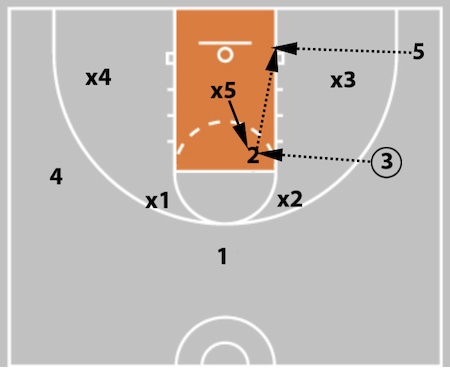
2 should look to shoot if X5 stays back.
5 should look to cut behind the zone on 2’s catch. They will often be open for a pass at the rim, especially if X5 steps up to guard 2.
1, 3, and 4 should find an open passing window for a kick out 3.
Skip pass:
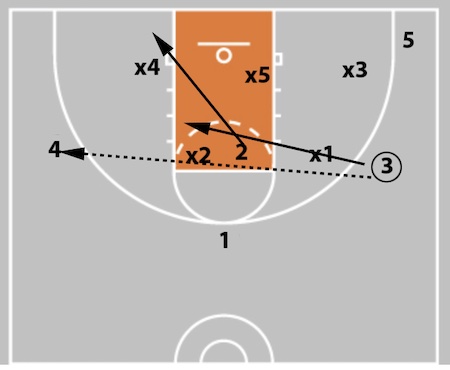
If the ball is skipped, you can quickly attack the high post and short corner.
In this scenario, the player in the high post cuts to the ball side short corner.
The opposite wing makes the blind cut to the high post discussed above.
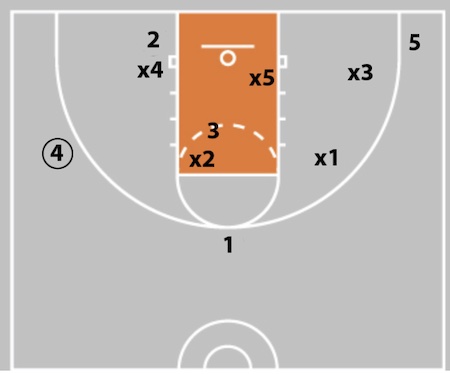
4 should look to shoot or for 2 in the shorter corner or 3 in the high post.
Reversal rule:

If the ball is thrown back to the top, 2 should hold for :01. This allows 1 to pass to them if they are open.
If they aren’t open, 2 should fill back out to the open corner.
This puts you back in your starting formation.
1 should look to reverse the ball quickly to 4 or boomerang it right back to 3.
Flare screen option:
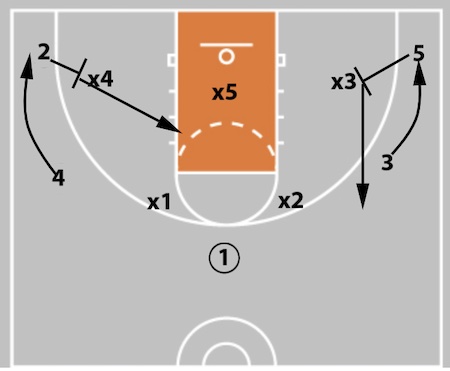
A final option from 5 Out is to set flare screens with the corner players. This is a great option if you have good shooters.
Here, 2 and 4 set screens on X4 and X3. If 4 and 3 are open, 1 can pass to them for an open shot.
After screening, players can fill (5) or flash into an open area (2).
The Adaptability of 5 Out
If you can use the same formation against both man and zone, the game becomes easier for your players.
They have less to remember.
This allows them to focus on playing rather than trying to remember their next action.
Try 5 Out against zone and see your team get great looks!
If you’re looking for more great ideas that incorporate these ideas, check out Continuity Zone Offense And Concepts To Beat Any Zone Defense.
5 Out Basketball Transition Offense - Part 1
If you are going to run a 5 Out offense, it makes sense to “arrive” in the half court in that formation.
By arrive, I mean that your transition offense ends with you in a 5 out formation.
The good news is, this is easy to do. Let’s dive in!
5 Out Basketball Transition Offense
Make transition:
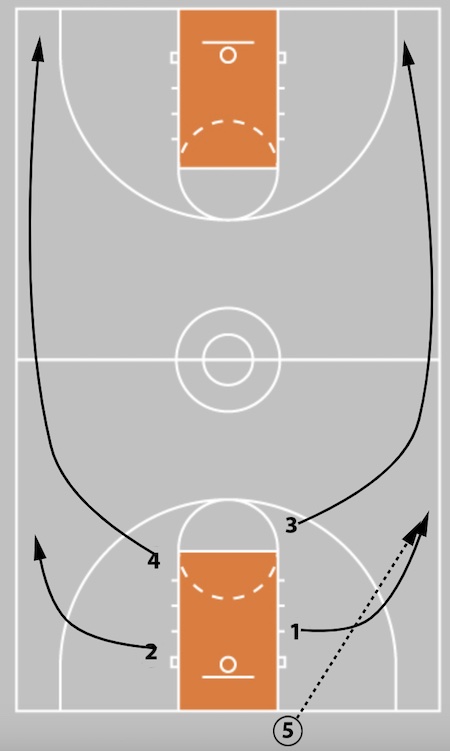
Start by determining your inbounder. Some teams have a set inbounder. Some teams have the closest player inbound. I’ve found that a set inbounder is easiest, at least early in the year.
The inbounder’s (5) job is to inbound the ball as quickly as possible. They must clear the backboard. That way if they throw a long pass it doesn’t hit the backboard.
Your two guards (1 & 2) should get wide. Most players run back through the middle of the floor. Getting wide makes them easier to pass to.
They should also get as deep as possible. If your opponent is not pressing, they should look to catch the ball as close to half court as possible.
Your other two players are sprinting to the corners. As with you guards, they need to get wide first. After getting wide, they should get deep. Too many players stop before getting to the corner, shrinking gaps.
For the players sprinting deep, you can designate them if you like. You could also have the first two players out in transition fill the corners.
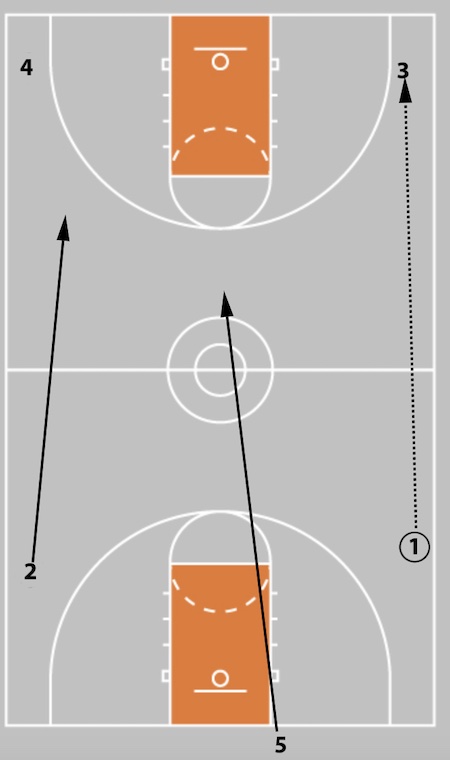
The first option is to pass the ball ahead. If 1 can throw the ball ahead to 3, they must immediately do so.
This can result in 1v1 opportunities for 3 before the defense gets back.
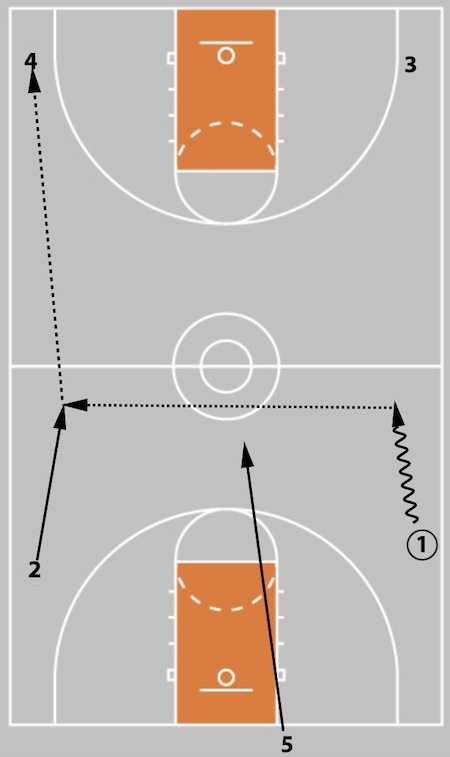
If 1 can’t throw it ahead, they should look to throw it across. This changes the ball side and help side.
Most teams load to the ball side in transition. That means a pass across make the whole defense shift.
2 can then attack with the dribble or throw it up to 4.
It’s important that 2 stay in line with 1. If they get too far ahead, it causes two problems.
First, it makes the pass from 1 to 2 much harder, as 2 is likely to be closer to the defenders.
Second, it shrinks the space between 2 and 4, making them easier to guard.

If 1 cannot pass to either 3 or 2, that means the defense is spread out and looking to take away passes.
In that scenario, there should be space for 1 to attack with the dribble.
1 will push hard and look to get into the paint and create an advantage.
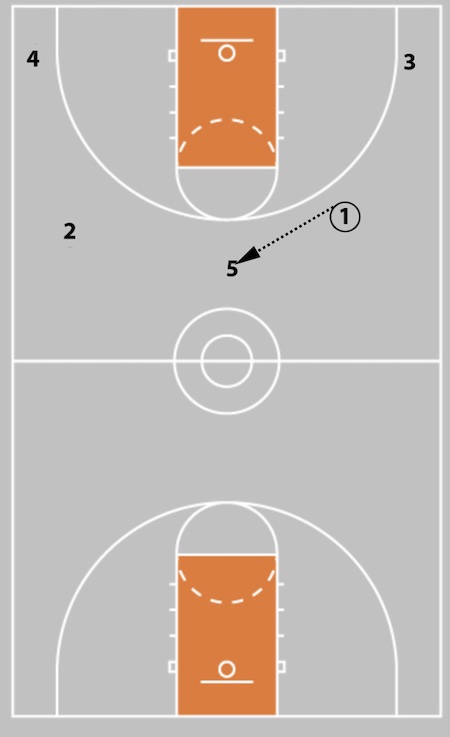
If 1 cannot penetrate, they can play through the trail (5). This centers the ball.
From here, you can get into any number of actions - dribble at’s, zoom action, flares, etc.
It’s a great way to start your 5 Out offense if you can’t score in transition.
Miss transition:
On a miss, spots will be more random. Yes, you want to arrive in 5 Out. But the first goal should be to score in transition.
If a player can get behind the defense for a layup, they should.
This could be a rim runner or any player who has an advantage on their defender. If they catch a pass for a layup, great. If not, they can clear to an available perimeter spot to set up 5 Out spacing.
If not, send the first two players to the corners. The next two players should fill the wing spots. The last player can fill the trail/top spot.
Get Layups With 5 Out Transition
One of the biggest strengths of 5 Out offense is that it takes away a defender at the rim.
While that helps you all the time, it’s even more beneficial in transition.
In transition, defenses tend to be disorganized.
Arriving in 5 Out allows you to exploit the open paint and get easy buckets early in possessions!
Learn some actions you can flow into from transition in the Early Attack Offense With Ryan Schultz.
5 Out Basketball Transition Offense - Part 2
In the 5 Out alignment section, we showed a formation that is used by Coach Rob Brost in his transition offense.
Instead of having the floor balanced, your team arrives with a 3 player side and a 2 player side. This formation gives your team some different options.

Here’s some more from Coach Brost on this 5 out transition spacing and the options it presents your team.
To learn his entire system, check out Get Comfortable Playing At An Uncomfortable Pace With Rob Brost.
5 Out Basketball Offense Press Break
You might be thinking 5 Out is ideal for your team’s offense.
But what if your opponent is pressing? Can you keep the same offensive principles or do you have to start over?
Good news - if you run 5 out, you can maintain the same offensive principles in the full court and the half court!
5 Out Press Break
You start in your normal transition positions. This is important. Why? Because the goal is not to run your press break. The goal is to attack in transition before the press can set.
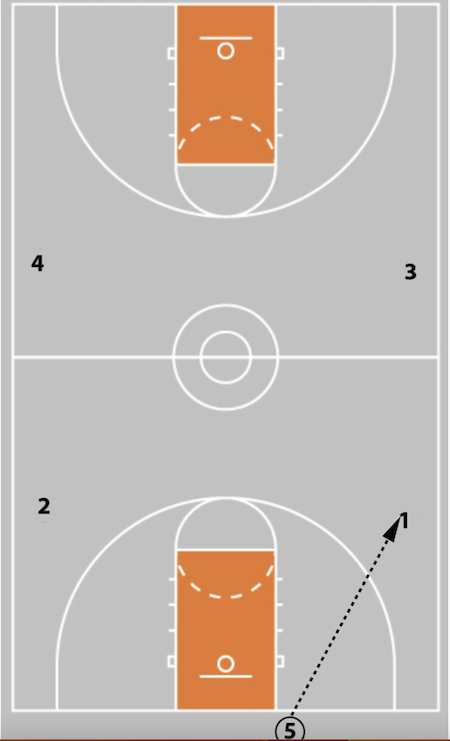
For our purposes, let’s assume you can’t attack in transition.
As usual, 5 inbounds to 1. 1 should try to catch the ball as deep as possible to make them harder to trap.
If 1 is denied, they can look to banana cut across their defender or screen with 2.

On 5’s pass, normal rules apply.
5 cuts to the middle of the floor and settles in an open area. This simulates a basket cut in the half court. Every press break should have a middle option. In 5 out, the pass fills that spot.
2 fills the spot 5 vacated. It’s important that 2 get behind the ball and to the ball side. This makes 1’s pass easier if they are being trapped.
1’s options are: A) up the floor to 3, B) 5 in the middle, C) 2 in the safety spot.
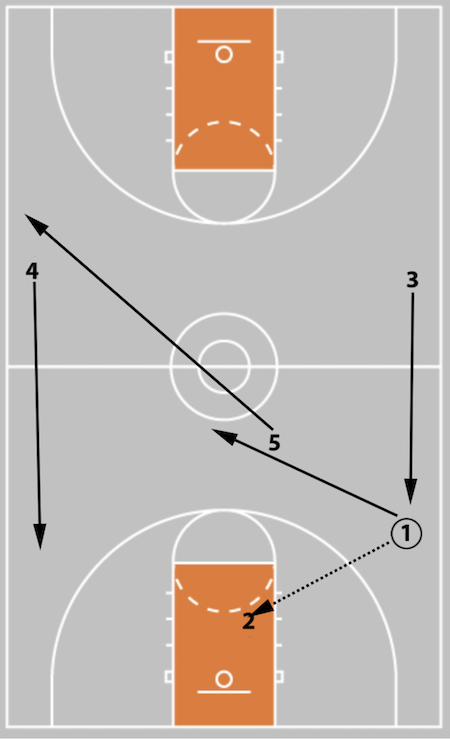
If 1 reverses the 2, normal rules apply again.
1 cuts to the middle. 5 fills out to the open corner.
4 & 3 fill up.
If 1 isn’t open, 2 should immediately reverse the ball to 4.
By reversing the ball, you make the press rotations longer.
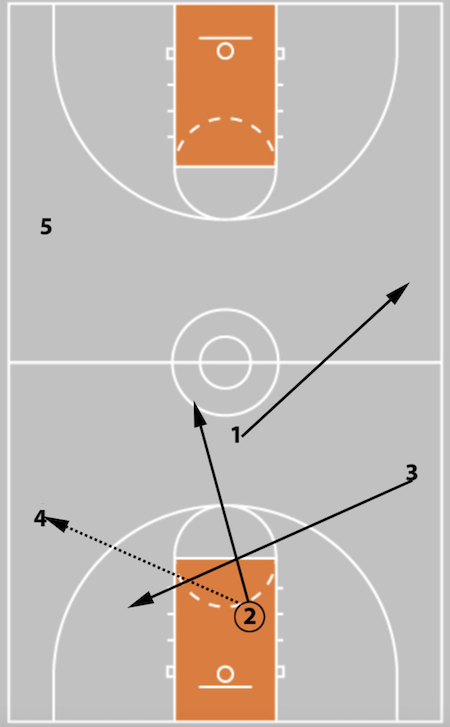
2 reverses to 4. 2 then cuts to the middle.
1 fills out.
3 fills 2’s spot, getting behind the ball and to the ball side.

As soon as the ball gets to the middle, the press break is over. The goal now is to attack.
Here, 4 hits 2 in the middle.
2 attacks with 5 & 1 running the wings.
Simplicity Is The Ultimate Complexity
The more your players have to remember, the more time they spend thinking rather than reacting.
By using a 5 out press break, you don’t have to teach a whole new attack.
You simply extend your 5 out offense to the full court.
As a result, you’ll be begging teams to pressure. They press, you make them pay!
5 Out Basketball Offense Drills For Any Offense
Like any coach, you want to tailor your drills to the needs of your team.
If you’re running 5 Out, what are those needs?
In my experience, there are 3 core concepts you must get good at to be an effective 5 out team.
Reading and playing off filling open spots
Cutting with purpose and hitting cutters
Reacting to penetration to solve the single gap issue
Let’s look at drills you can use to address those 3 concepts.
Filling with Pace
Filling open spots is a crucial part of 5 Out offense. There are a couple mistakes players make when filling open spots:
-
Jogging their fill cut
-
Hugging the 3 point line
-
Not scanning to their defender prior to the catch
1v1 Fill Drill
The 1v1 fill drill with progressions works on all these elements.
We first drill this with guided defense.
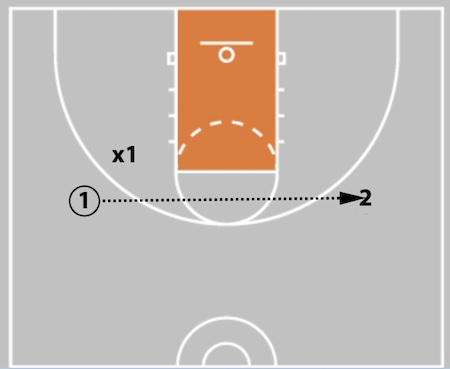
Player 1 starts on the wing with a ball. They are guarded by X1. Player 2 is on the opposite wing. The drill begins with 1 passing to 2.
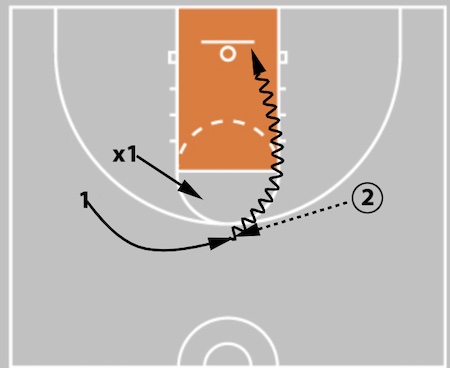
After passing, 1 will fill the open spot at the top of the key.
The defender can play defense 1 of 4 ways. They can trail the cut, as seen above.
In that circumstance, 1 wants to run through the pass and turn the corner for a layup.

X1 could overrun the cut.
1’s read would be to catch and rip opposite of the pass.
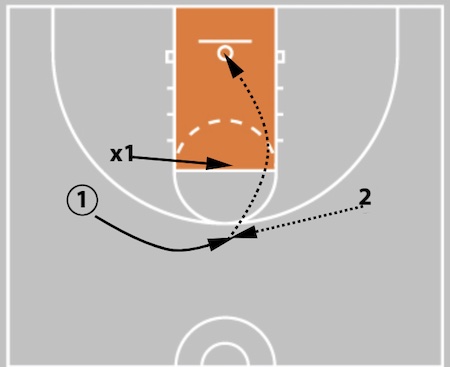
X1 could drop way back.
1 should see the space and catch and shoot.

X1 could deny the pass to 1.
1 should make a hard backdoor cut and look to catch a pass for a layup.
Have the defender use a different coverage each time.
2 Key Teaching Points:
-
Scanning - as 1 fills the top, they should be peaking at X1 to see how they are defending. That allows them to know what they are going to do before the catch the ball.
If they wait until they catch the ball to read the defense, their advantage will be gone.
-
Filling off the 3 point line - catching and shooting is a great option if X1 drops. 1 should fill the open spot on a slight loop.
This makes scanning easier. It also makes turning and shooting easier. Finally, extra space prevents them from stepping on the line when shooting their shot.
Progression: 1v1 Fill Live
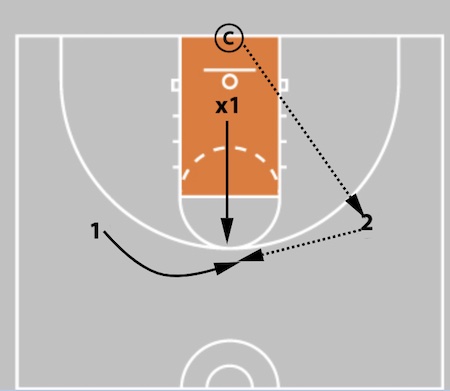
X1 starts under the rim. You can have X1 start with the ball (as in the video) or have the coach pass (as shown above). Offensive players start on each wing.
The coach passes to a wing player.
The opposite wing player sprints and fills the top.
The defender closes out on the player filling the top.
It’s live on the catch.
One rule for this drill is the player must shoot or drive immediately. This reinforces scanning before the catch.
Progression: 2v2 Fill Live
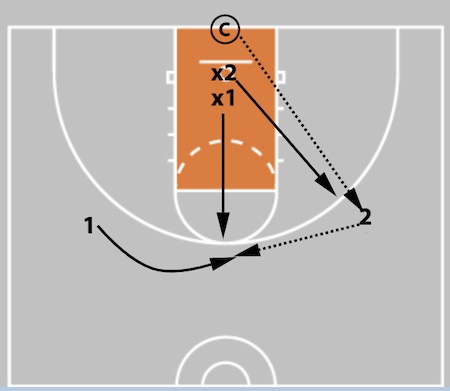
You can also build the drill to 2v2.
This allow you to work on your penetration reaction (more on that below).
You now have 2 defenders under the rim. The first defender still guards the player filling the top.
The bottom defender guards the player who catches the first pass.
When the ball gets to the top, it’s live.
Cutting & Passing
Cutting and passing is a second core competency for 5 Out Offense.
To develop that skill, play 5v5 no dribble.
5v5 No Dribble
Play 5v5 from your 5 Out formation. The offense is not allowed to dribble.
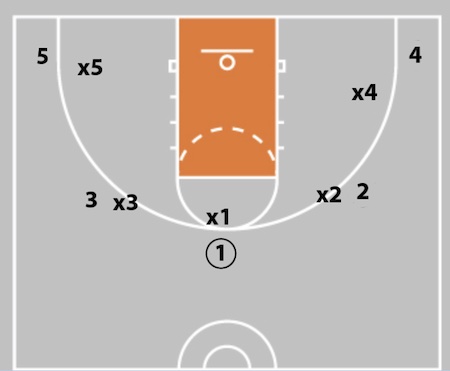
Make each pass worth 1 point. This incentivizes the defenders to deny every pass.
(Remind them that the offense can’t drive past them so they must apply intense ball pressure.)
Baskets are worth normal amounts.
Because the defense is trying to steal or deny every pass, your players get a lot of practice at cutting backdoor. (Remember that’s one of the rules - if you are denied, you automatically cut backdoor).
Your passing will improve as well. This drill forces the player with the ball to be strong and pivot to find passing windows.
Players will learn to look for cutters instead of turning their back when pressured.
Progression: 5v5 Dribble-At Only
One rule of many 5 Out offenses is that a dribble-at cues a backdoor. If you like that, you can progress the game to Dribble-At only.

The offense is still not allowed to penetrate. However, they can dribble-at a teammate as a pressure release. As soon as 1 starts dribbling at 2, 2 cuts backdoor. 1 is looking to throw a bounce pass for a layup.
Penetration Reaction
The third core concept you’ll want to focus on is dribble penetration.
As noted in the weaknesses of 5 Out, the formation leads to a lot of single gaps.
Those gaps are harder to drive through.
To create driving lanes, the other 4 players must be ready to react to penetration.
One common penetration reaction system is push/pull.
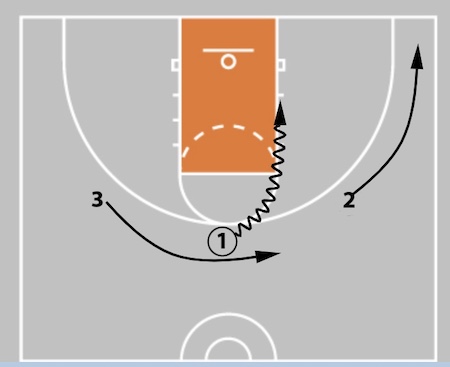
This means that if the ball is driven at you, it pushes you to the next spot.
If the ball is driven away from you, it pulls you to the next spot.
In the diagram above, 1’s drive pushes 2 to the corner and pulls 3 to the top.
The push part is particularly important for maintaining driving lanes. When 2 sprints to the corner, it prevents their defender from being able to help on the drive and get back to 2 in the corner.
Here are a couple other push pull examples.
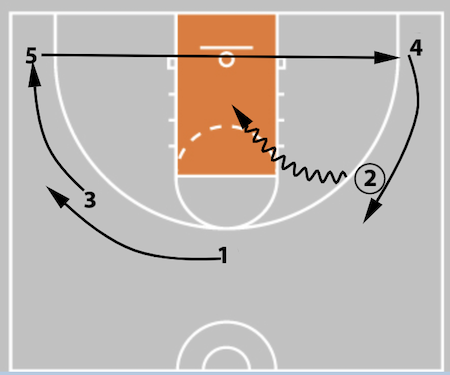
Note that on any middle drive or drive from the top, all 5 players are in motion.

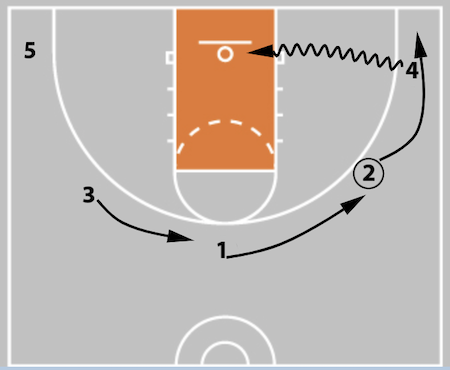
On outside drives, we see some exceptions. The simple reason why is because we want to have players filling the corners on every drive.
You’ll notice on every example there is a player in the headlights (in front of the drive) and the taillights (filling the spot the driver started from).
5v4 Push Pull
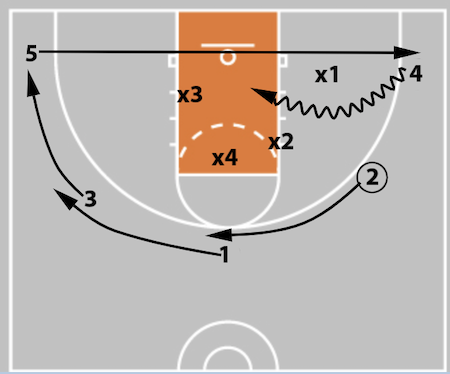
Start with 5 offensive players and 4 defense players. You can have the defense throw the ball to an offensive player to start. Conversely, you can throw the ball to an offensive player.
On the catch, the offensive player must drive immediately. The other 4 players carry out their push/pull responsibilities.
The defense works on guarding at a disadvantage (so this drill helps your defense, too!).
A couple ideas you might work into the drill:
-
A shot clock or pass limit since the offense has a player advantage
-
No consecutive drives (if you want that to be a principle of your offense).
You can play the possession through the rebound. Alternatively, to still emphasize rebounding but neutralize the advantage, you can play it a shot and a tip.
Progression: 5v5 Back Attack Push Pull

Start 5v5. The player guarding the ball turns and faces the basket.
4 places the ball on X4’s back. It’s live when 4 starts their drive.
This progression still gives the offense an advantage, but a smaller advantage than 5v4.
One idea for this progression:
-
Give the offense bonus points if they can maintain the advantage the whole possession. In other words, if they keep the defense scrambling the whole possession, baskets are worth double.
If the defense gets back to neutral at some point during the possession, the bonus points are gone.
Using The Pareto Principle To Guide Your Practices
Playing 5 Out requires the ability to do certain things. If you can get really good at those skills, your offense will flourish.
The Pareto Principle says 80% of our success comes from 20% of our actions. If you can get really good at cutting, filling with pace, and reacting to penetration, the rest of your offense will fall into place!
Use the drills above to master the 20% and see your offense blossom!
To see drills like these and more, click the box below!
10 Plays For Your 5 Out Basketball Offense
Here are 10 plays you can run from a 5 Out alignment. Choose the ones that fit your personnel best and use them to get your team a great shot!
77
Drag ball screens are very popular. Here is a way to isolate a post player utilizing a hi-lo pass.
This play is especially effective against switching defenses.
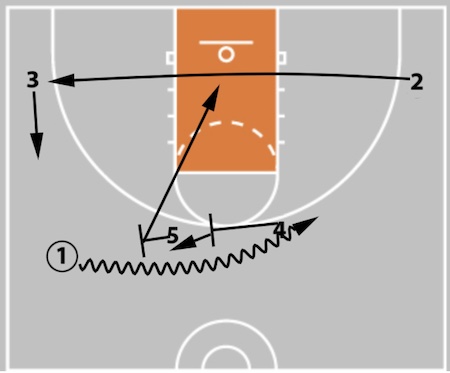
1 uses a double drag ball screen from 5 and 4.
As 1 moves towards the screens, 2 clears through to the opposite corner.
3 lifts to the wing behind the ball screens.
5 rolls while 4 pops.

If 1 can’t turn the corner off the ball screens, they look to throw to 4 on the pop.
5 rolls to the rim then turns and seals.
4 looks to enter the ball to 5 for a post up opportunity.
77 STS
77 STS (screen the screener) is another double drag screen play. This one incorporates screen the screener action, creating multiple scoring opportunities.
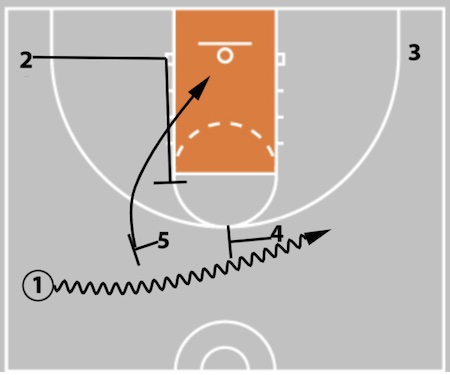
1 comes off the ball screens from 5 & 4.
2 mirrors 1’s movement across the floor. At the block. 2 comes up to set a back screen for 5.
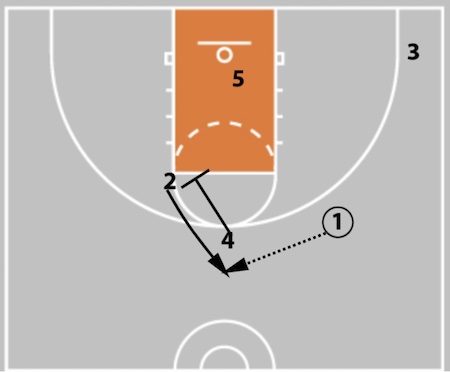
After setting their screen, 4 sets a down screen for 2.
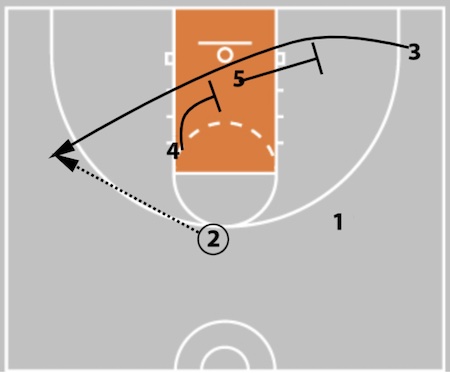
2 looks for the shot. As the ball is in the air to 2, player 3 comes off a baseline stagger screen from 5 & 4.
If 2 isn’t open, they should look to hit 3 coming off the stagger for a shot or drive.
Clemson
Clemson is a set to create a big driving gap for your 1 player off a handoff or pitch from your 5.

1 comes down the right wing and hits 5 trailing to the top.
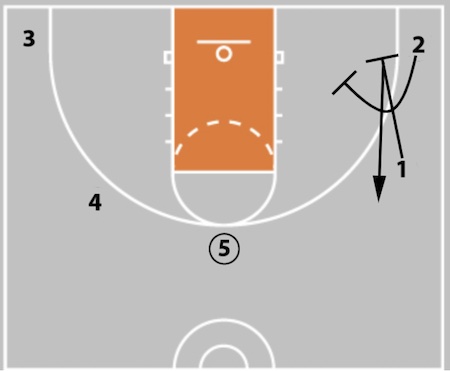
After passing to 5, 1 sets a down screen for 2.
2 curls off the screen and immediately rescreens for player 1, who pops back to the wing they started from.
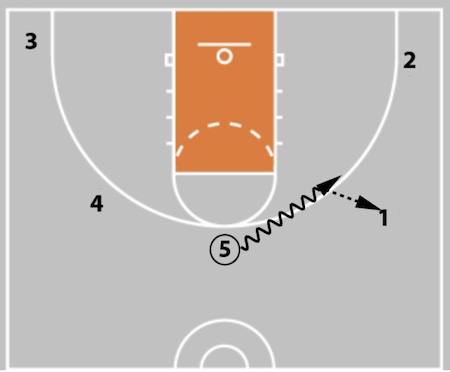
5 dribbles at 1 as 1 comes off the downsceen.
Depending on the position of 1 & 5’s defenders, 5 will handoff or pitch the ball to 1.
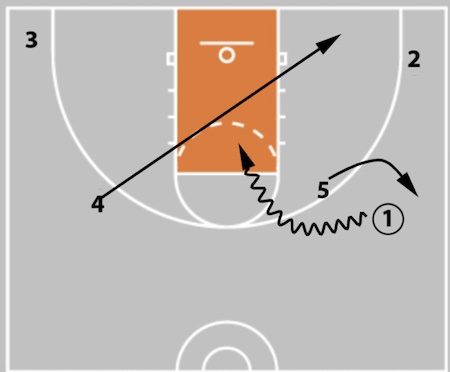
As the pitch or hand off is occuring, 4 will make a hard cut across the lane.
If their defender helps on 1’s drive, 1 can look to pass to 4 for a layup.
If x4 goes with 4, 1 has a triple gap to attack.
Clipper
Clipper uses multiple screens to create potential advantages for a shot or drive. It’s a great play to run with good shooters in the 3 & 4 spots.
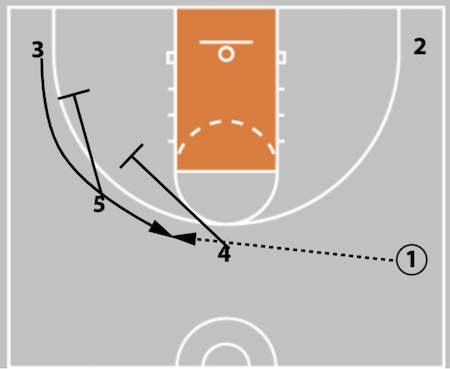
As 1 brings the ball down the side, 5 & 4 set a stagger screen for player 3 in the opposite corner.
3 receives a pass off the stagger.
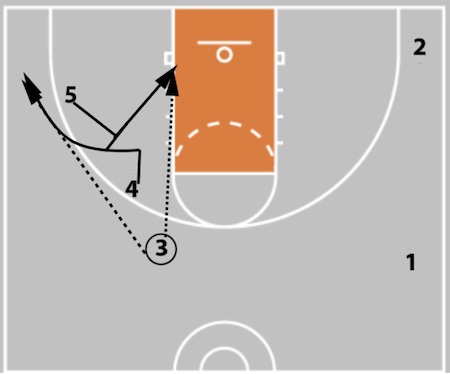
As the ball is in the air to 3, the second screening action begins.
5 turns around and sets a flare screen for player 4.
5 should look to screen the bottom half of 4’s defender. After setting the flare, 5 slips to the rim, looking for a pass.
3 reads the screening action and hits 4 or 5.
Euro
Euro ball screen continuity is a popular offense. It can easily be gotten into from a 5 out formation.

1 dribbles down the sideline, pushing 2 through to the other side.
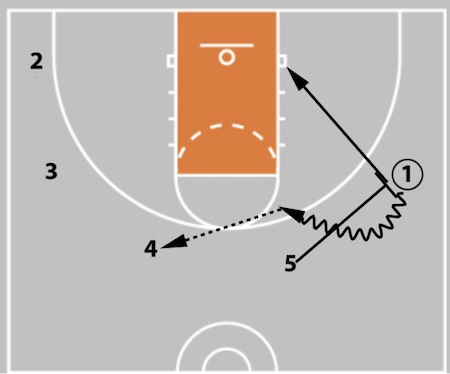
5 sprints into an empty ball screen with 1.
5 rolls.
If 1 can’t turn the corner or hit 5 on the roll, they reverse the ball to 4.
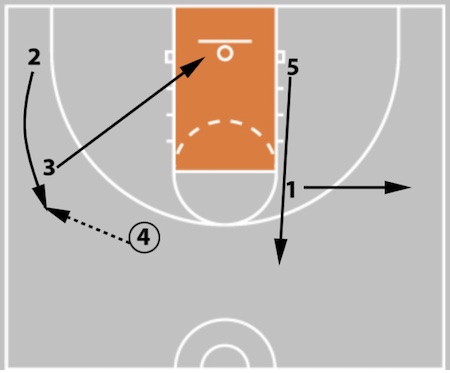
As 4 pivots at 3, 3 cuts backdoor and clears to the opposite corner.
2 fills up out of the corner.
5 lifts and 1 spaces to the wing.
4 passes to 2 and follows into a ball screen, continuing the pattern.
Flex
Flex is another popular continuity offense that can easily be started from a 5 out formation.
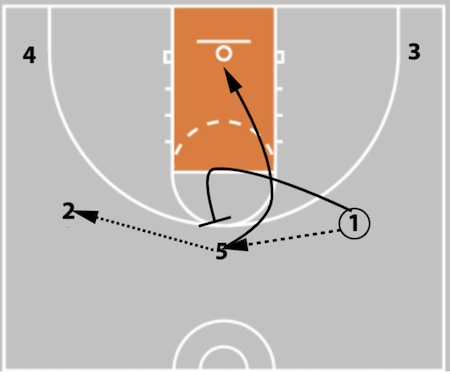
1 reverses the ball to 5.
5 immediately reverses to 2.
1 loops through the free throw line and sets a back screen for 5. 2 looks for 5 at the rim.

If 5 isn’t open, 1 pops out and receives a pass from 2.
This starts the flex action.
4 runs off 5’s baseline flex screen.
2 screens downs for 5. 5 pops out to the perimeter.
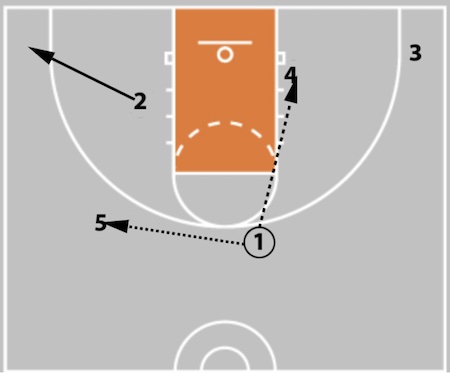
4 is 1’s first look.
If 4 isn’t open, 1 should pass to 5.
5 can look to shoot, or the flex can continue with 4 screening for 3 and 1 down screening for 4.
Ghost
Ghost combines a ghost screen action with a backdoor opportunity.
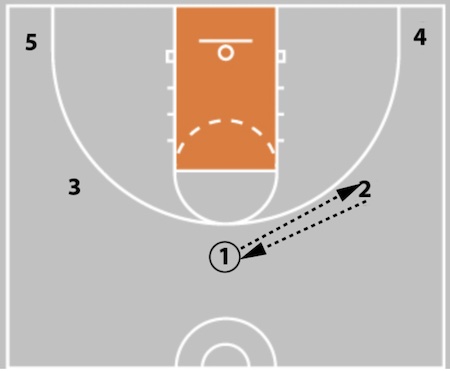
1 passes to 2 who immediately passes back to 1.
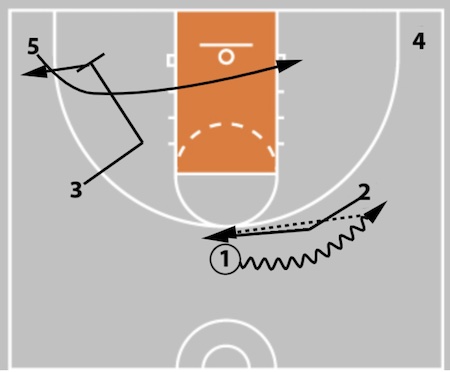
2 follows their pass into a ghost screen with 1. This might create conufse the defense, creating an advantage for 1 or 2.
If not, 1 passes to 2 at the top of the key.
At the same time, 3 down screens for 5. 5 curls to the basket.
2 should pass to 5 if they are open.
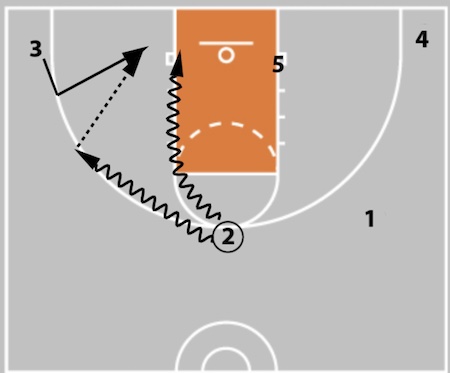
2 has a couple options if 5 isn’t open.
If they can catch and rip opposite, they have a double gap to drive.
If that’s not available, they should dribble at 3, who is in the corner after setting their down screen.
3 sprints at 2 like they are going to take a handoff, but then cuts backdoor to receive a pass for a layup.
Pacers
Pacers is a good end of quarter play. It creates space for a driver while opening up shot and slip opportunities as well.
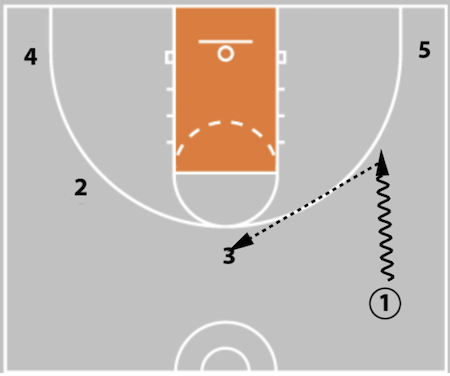
1 dribbles down and hits 3 trailing to the top. 3 should be your best driver.
1 & 2 should be your best shooters.
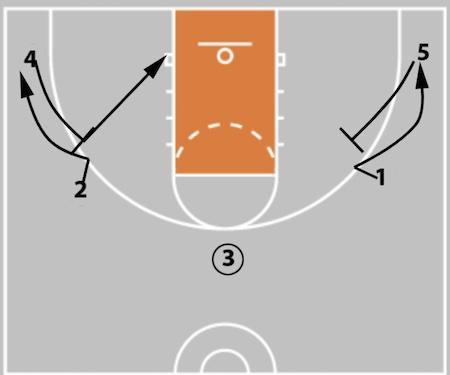
4 & 5 sprint out of the corners to set flare screens for 1 & 2. Depending on how their defenders guard the screen, they can slip (4) or pop.
While this is going on, 3 can look to attack the rim. It’s a good time to drive as the other 4 defenders are engaged in the flare screen actions.
Spurs
Spurs is a hammer action play. It’s a great play for when you need a 3 point shot.
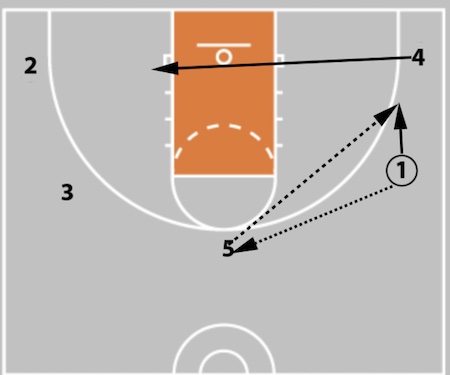
The play starts with 1 hitting 5 at the trail spot.
5 passes back to 1 as 4 clears through to the opposite block.

When 1 gets the ball back, they immediately rip and attack the baseline.
4 sets a back screen on 2’s defender as 2 slides to the corner. That’s the first look.
5 screens away for 3, who fills behind 1’s drive.
If 1 is cut off, they can reverse pivot and look for 3 behind.
4 and 5 can look to slip after their screens.
Zoom
Zoom action is everywhere. You can easily and quickly get into zoom from 5 out. It’s a great option in transition.
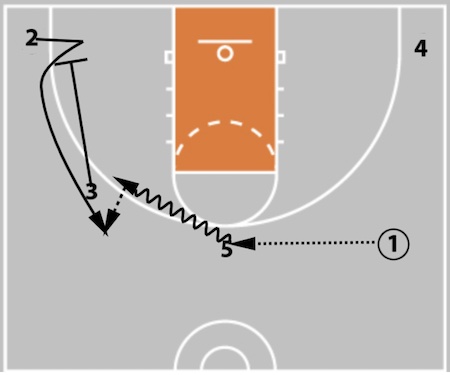
1 hits 5 in the trail spot.
3 down screens for 2.
5 dribbles as 2.
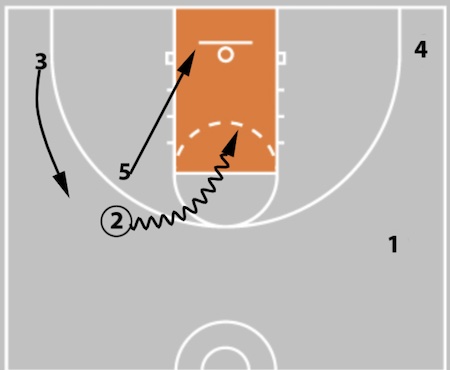
2 and 5 execute the zoom action. In this case, 2 takes the pitch from 5 and turns the corner.
5 rolls and 3 lifts behind the action.
1 and 4 spot up on the weak side.
Find other great 5 out plays in The Complete Offensive System With Tim Schuring.
5 Out Continuity Basketball Offenses
Continuity offenses in basketball follow a pattern. Some people would consider a 5 Out, pass & cut offense a continuity.
Whether you agree or disagree with that, we won’t cover that here, as we’ve already covered basic 5 Out offense rules.
Instead, we’ll look at 3 continuity offenses you can run from a 5 Out formation.
Why run a continuity? Some coaches like them as a change of pace.
Maybe you run a conceptual offense as your primary offense. However, your ball movement is bogging down. Going to a continuity for a few possessions can be an effective way to get the ball and players moving again.
Other coaches run a continuity as their primary offense (the flex would be a good example of this, albeit not a 5 Out offense).
After players have mastered the basic pattern, they learn the intricacies that take the offense to a higher level.
Here are 3 continuity offenses that fit with 5 Out philosophy:
Hoosier
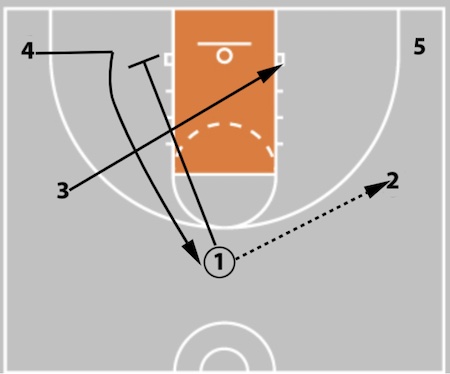
Players start by filling the point, the wings and the corners.
1 enters the ball to the wing. They immediately screen for the player in the opposite corner (4).
3 cuts right off 1’s back. This brush cut acts as a screen to try and open up 3 for a layup. That’s the first look.
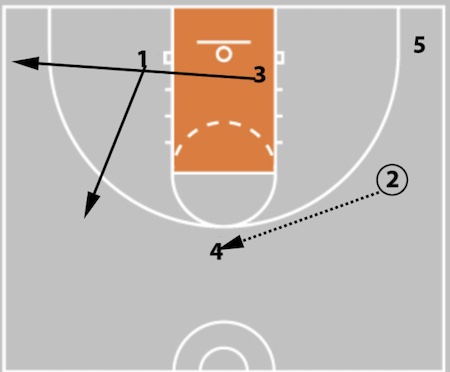
If 3 isn’t open, 2 looks at 4 filling the top. 4 may be open for a shot or drive.
After screening for 4, 1 fills up to the wing.
If 3 doesn’t receive a pass on their cut, they will out to the corner, reestablishing 5 Out spacing.
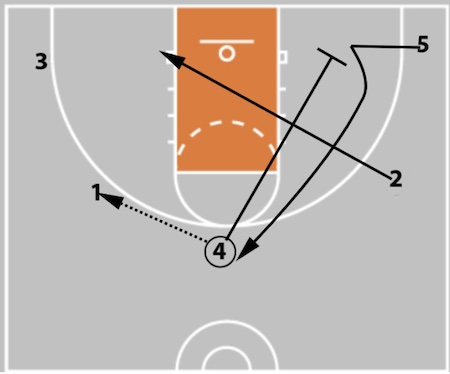
4 would look to quickly reverse the ball to 1. The pattern would then repeat.
4 screens for the opposite corner (5).
2 cuts off 4’s back looking for the ball.
UCLA
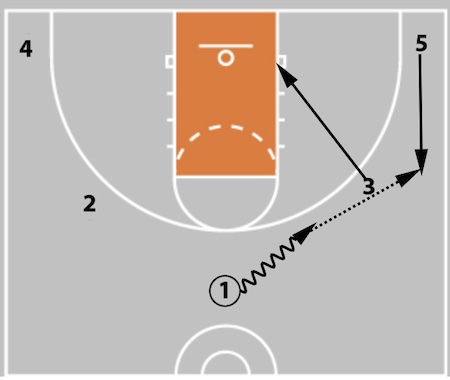
From traditional 5 Out spacing, UCLA is initiated with a dribble at. 1 dribbles at 3, sending them backdoor. This is the first option.
5 fills the vacated wing. If 3 is not open, 1 passes to 5.
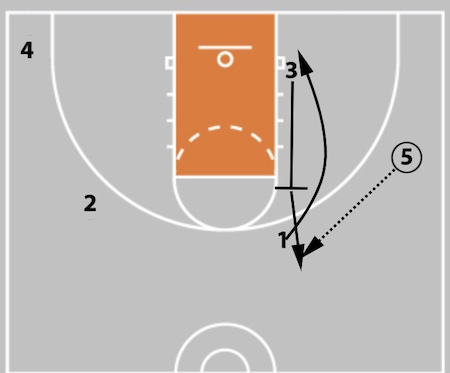
3 sets and UCLA screen for 1. 1 can cut on either side of the screen, depending on how they are being guarded.
5 looks for 1. 3 pops out after their screen.
If 1 is not open, 5 can reverse the ball to 3.
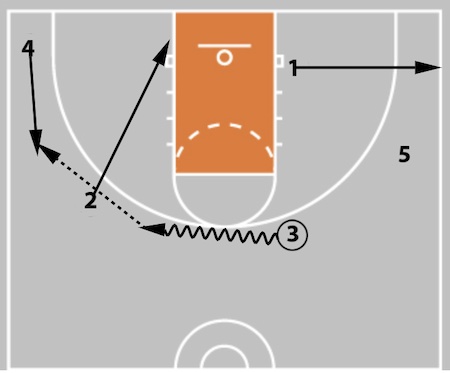
3 dribbles across the top at 2, initiating the back door.
4 lifts. If 3 passes to 4, that would cue 2 to set another UCLA screen for 3, continuing the pattern.
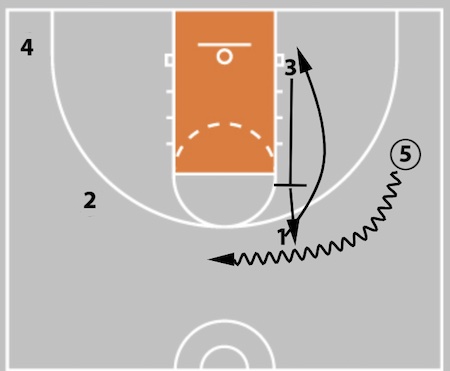
The ball can also change sides with the dribble. Instead of passing to 3, 5 can dribble above 3.
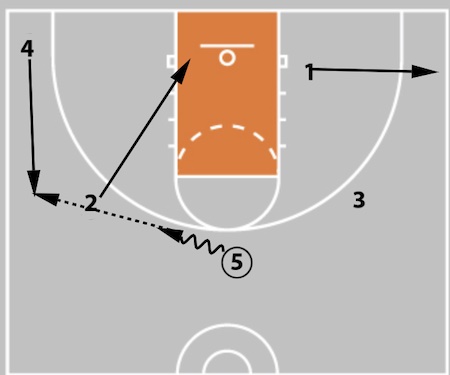
As 5 continues towards 2, 2 would cut backdoor, restarting the pattern.

Anytime the ball is entered to the post, that triggers split action on the ball side.
The wing (4) goes and screens for the player up top (5). They read the defense and respond accordingly.
The split action also occupies their defenders, allowing 2 more room to operate in the post.
Pistol
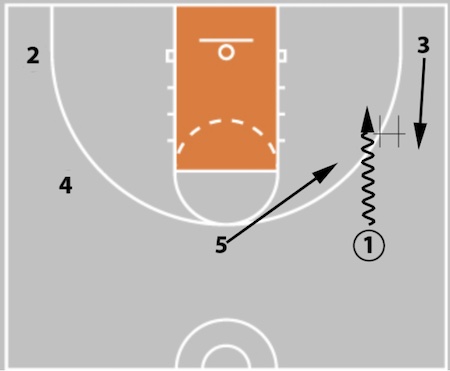
Pistol is a ball screen continuity offense. It is a pattern of a handoff followed by a ball screen.
To start, 1 executes a handoff with player 3.
5 moves towards that side.
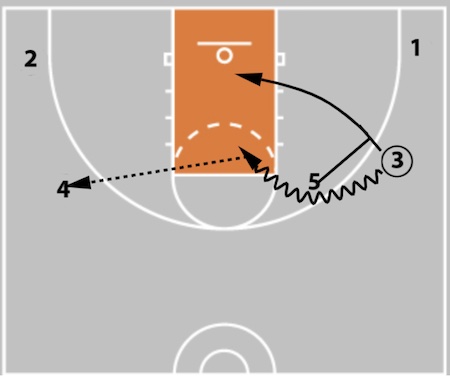
5 follows right behind 1 and sets a ball screen for 3. 5 rolls.
The other three players spot up.
If no scoring opportunity presents itself, 3 reverses the ball to 4.
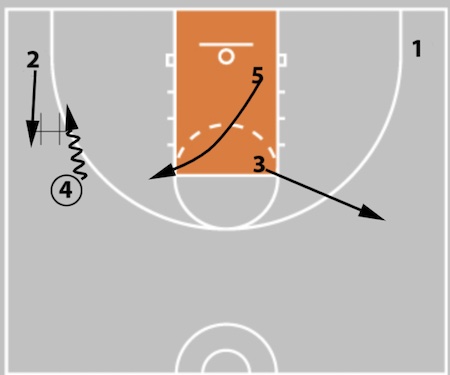
4 executes a handoff with 2.
5 sprints over for the next ball screen.
3 spaces back to the wing.
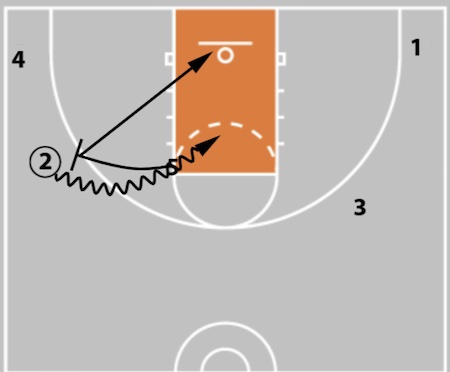
5 screens for 2, continuing the pattern.
5 Out Basketball Offense - The “Away” Screen Offense - Bring NBA Concepts To Your Level - with YouTube Video!
Last year, coach Brett Tipton wrote up how 5 out principles from the NBA can benefit teams at every level. He also included videos of each action. Check it out and see what can help your team!
And to see a full breakdown of the 5 Out Away Screen Offense, check out this video: with narration and access to a free PDF of the 5 out action!
If you like these types of motion concepts, click the box below!
5 Out Basketball Delay Game Offense
Have you ever lost a game at the end because you couldn’t protect a lead? I know I have.
This happens for multiple reasons - players foul out, missed free throws, the other team gets hot, etc.
That said, one common reason teams blow leads is because they don’t have a strong delay game.
Do you practice your delay game? You should.
Remember, it’s a good thing if you have to use it a lot - it probably means you’re winning a lot!
One great thing about 5 Out is that you don’t have to change much to make your basic 5 Out offense a delay game.
5 Out Delay
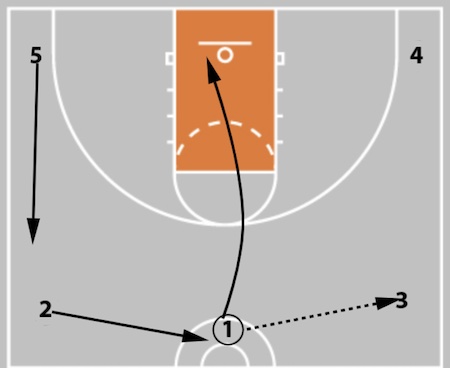
When you run 5 Out as a delay, you’ll have the same 5 spots - point- wings and corners.
That said, you’ll want to utilize as much space as possible.
In the diagram above, you’ll notice that 1, 2, & 3 are elevated towards half court.
That said, they are not all the way to half court. This is important. Going all the way to half court would further increase space. However, it would put those players in a worse position if they got trapped.
Staying a couple steps off the half court line and sidelines gives players more room to operate if trapped.
When running your delay, the same general pass and cut rules apply. The increased space might open up more passes to cutters.
In delay, it’s important to look to reverse the ball. That keeps the defense moving and makes it harder for them to trap. In the diagram above, if 2 were to receive a pass from 3 filling the top, they should look to immediately reverse to 5.
The increased space can also open up driving lanes. Whether you want players to drive to score is up to you. That will likely depend on the time and score.
It’s crucial that you go over this with your team ahead of time. If not, you’re leaving it up to them in real time.
For those that run ball screens in their 5 Out, I’d recommend not doing that in a delay situation. That brings 2 defenders to the ball, creating a natural trap.
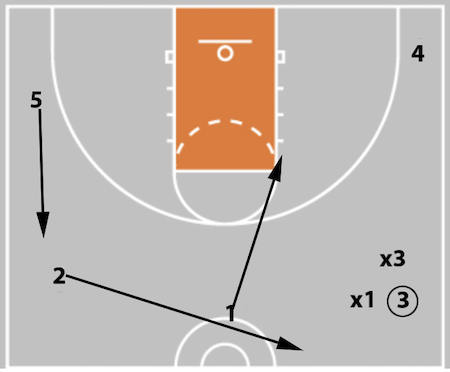
If you run your delay well, your opponent will have to take some risks. Trapping is one way this happens. The sidelines are the most obvious place to trap.
In the scenario above, the defense trapped 1’s pass to 3.
1 should still cut. However, instead of cutting all the way to the rim, 1 should stop around the ball side elbow and make themself available.
2 should fill but now should fill even further. They will want to get behind the ball (closer to half court) to present a passing option to 3.

5 will be the deep option. If needed, 4 can fill up from the corner.
Teach your players to ask themselves this question in situations like this - “does my teammate need space or support?”

As a general rule, you will want to use the corners less when in your delay game. This is because the corners are the best spot for the defense to trap.
That said, if you do throw it to the corner and get trapped, players need to know how to respond.
3 should cut but direct their cut towards the ball side block.
1 must sprint and fill behind the ball towards the sideline.
2 should sprint and find an open spot near the top of the key or ball side elbow.
Finally, 5 can’t sit in the opposite corner. 4 can’t throw the ball through the backboard. Thus, if 5 doesn't move, they aren’t an option.
5 should lift out of the corner to present a deep option.

Use 5 Out To Seal The Deal
The spacing of 5 Out offense makes it a natural fit for a delay game.
With only slight modifications, you can run your regular 5 Out offense. That gives players comfort and confidence, which are huge at the end of tight games!
Use 5 Out to close out games and add more W’s to your team’s record!
More 5 Out Basketball Offense Resources
We’ve covered a lot of ground so far! With that in mind, here are some additional resources that may be helpful as you develop a 5 out offense for your team!
Offenses
Zoom Offense & Resources
(ideal for middle school and up)-
Zoom offense implementation guide with sets and drills! (link at bottom of page)
For a FREE PDF Zoom Installation Guide With Plays & Drills, click the banner below!
Don Kelbick’s Motion Offense & Resources
(ideal at all levels)Tim Schuring’s Complete Offensive System
(ideal at all levels)Rob Brost Transition Offense & Resources
(ideal at all levels)Flow Motion Offense & Resources
(ideal for high school and above)5 Out “Away” Offense
(ideal for high school and above)5 Out Open Post Offense
(ideal for youth teams)Cutters
(ideal for youth teams)Drills
Additional Resources
To get a FREE PDF of 72 Drills & 33 Plays, click the banner below!
|
|||





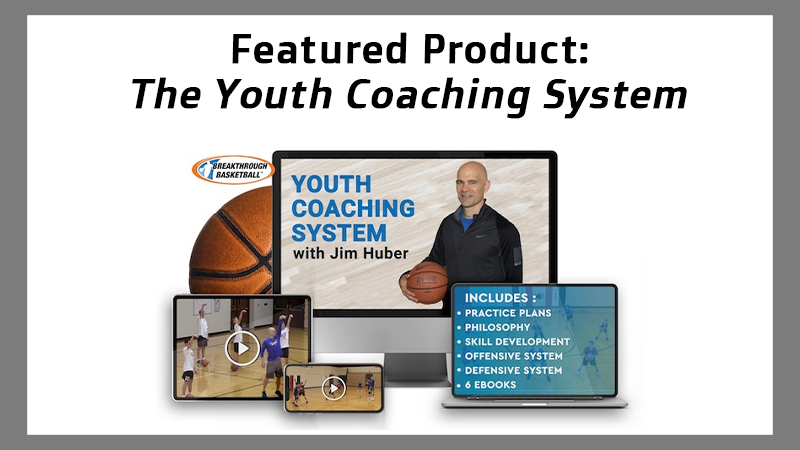
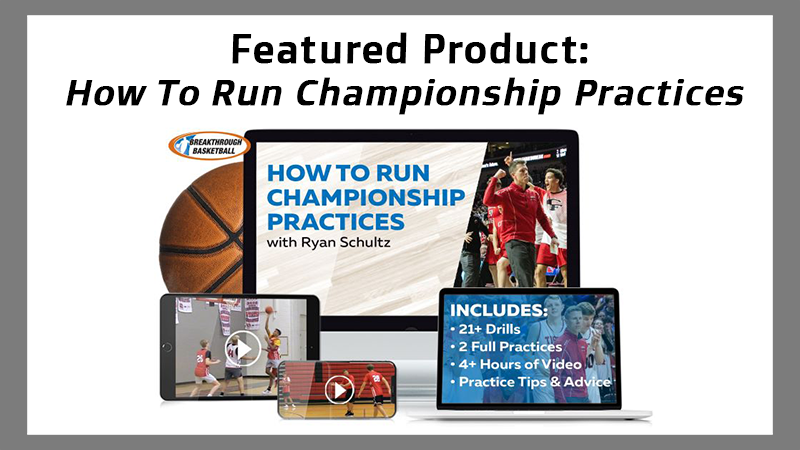



 Facebook (145k Followers)
Facebook (145k Followers) YouTube (152k Subscribers)
YouTube (152k Subscribers) Twitter (33k Followers)
Twitter (33k Followers) Q&A Forum
Q&A Forum Podcasts
Podcasts